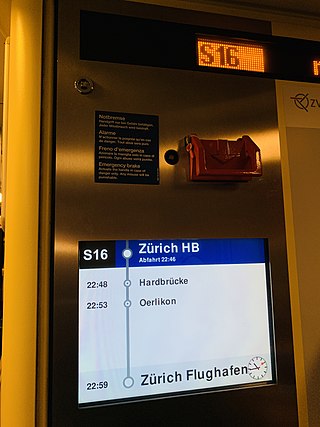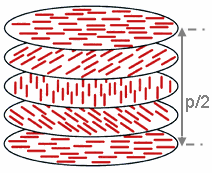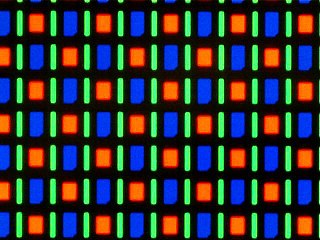
Electronic paper, also known as electronic ink (e-ink) or intelligent paper, is a display device that mimics the appearance of ordinary ink on paper. Unlike conventional flat panel displays that emit light, an electronic paper display reflects ambient light, like paper. This may make them more comfortable to read, and provide a wider viewing angle than most light-emitting displays. The contrast ratio in electronic displays available as of 2008 approaches newspaper, and newly developed displays are slightly better. An ideal e-paper display can be read in direct sunlight without the image appearing to fade.

A liquid-crystal display (LCD) is a flat-panel display or other electronically modulated optical device that uses the light-modulating properties of liquid crystals combined with polarizers. Liquid crystals do not emit light directly but instead use a backlight or reflector to produce images in color or monochrome. LCDs are available to display arbitrary images or fixed images with low information content, which can be displayed or hidden: preset words, digits, and seven-segment displays are all examples of devices with these displays. They use the same basic technology, except that arbitrary images are made from a matrix of small pixels, while other displays have larger elements. LCDs can either be normally on (positive) or off (negative), depending on the polarizer arrangement. For example, a character positive LCD with a backlight will have black lettering on a background that is the color of the backlight, and a character negative LCD will have a black background with the letters being of the same color as the backlight. Optical filters are added to white on blue LCDs to give them their characteristic appearance.
An active-matrix liquid-crystal display (AMLCD) is a type of flat-panel display used in high-resolution TVs, computer monitors, notebook computers, tablet computers and smartphones with an LCD screen, due to low weight, very good image quality, wide color gamut and fast response time.

A flat-panel display (FPD) is an electronic display used to display visual content such as text or images. It is present in consumer, medical, transportation, and industrial equipment.

An LCD projector is a type of video projector for displaying video, images or computer data on a screen or other flat surface. It is a modern equivalent of the slide projector or overhead projector. To display images, LCD projectors typically send light from a metal-halide lamp through a prism or series of dichroic filters that separates light to three polysilicon panels – one each for the red, green and blue components of the video signal. As polarized light passes through the panels, individual pixels can be opened to allow light to pass or closed to block the light. The combination of open and closed pixels can produce a wide range of colors and shades in the projected image.
A television set or television receiver is an electronic device for the purpose of viewing and hearing television broadcasts, or as a computer monitor. It combines a tuner, display, and loudspeakers. Introduced in the late 1920s in mechanical form, television sets became a popular consumer product after World War II in electronic form, using cathode ray tube (CRT) technology. The addition of color to broadcast television after 1953 further increased the popularity of television sets in the 1960s, and an outdoor antenna became a common feature of suburban homes. The ubiquitous television set became the display device for the first recorded media for consumer use in the 1970s, such as Betamax, VHS; these were later succeeded by DVD. It has been used as a display device since the first generation of home computers and dedicated video game consoles in the 1980s. By the early 2010s, flat-panel television incorporating liquid-crystal display (LCD) technology, especially LED-backlit LCD technology, largely replaced CRT and other display technologies. Modern flat panel TVs are typically capable of high-definition display and can also play content from a USB device. Starting in the late 2010s, most flat panel TVs began to offer 4K and 8K resolutions.

A field-emission display (FED) is a flat panel display technology that uses large-area field electron emission sources to provide electrons that strike colored phosphor to produce a color image. In a general sense, an FED consists of a matrix of cathode ray tubes, each tube producing a single sub-pixel, grouped in threes to form red-green-blue (RGB) pixels. FEDs combine the advantages of CRTs, namely their high contrast levels and very fast response times, with the packaging advantages of LCD and other flat-panel technologies. They also offer the possibility of requiring less power, about half that of an LCD system. FEDs can also be made transparent.

A backlight is a form of illumination used in liquid-crystal displays (LCDs). As LCDs do not produce light by themselves—unlike, for example, cathode ray tube (CRT), plasma (PDP) or OLED displays—they need illumination to produce a visible image. Backlights illuminate the LCD from the side or back of the display panel, unlike frontlights, which are placed in front of the LCD. Backlights are used in small displays to increase readability in low light conditions such as in wristwatches, and are used in smart phones, computer displays and LCD televisions to produce light in a manner similar to a CRT display. A review of some early backlighting schemes for LCDs is given in a report Engineering and Technology History by Peter J. Wild.
A thin-film-transistor liquid-crystal display is a variant of a liquid-crystal display that uses thin-film-transistor technology to improve image qualities such as addressability and contrast. A TFT LCD is an active matrix LCD, in contrast to passive matrix LCDs or simple, direct-driven LCDs with a few segments.

Image persistence, or image retention, is the LCD and plasma display equivalent of screen burn-in. Unlike screen burn, the effects are usually temporary and often not visible without close inspection. Plasma displays experiencing severe image persistence can result in screen burn-in instead.

A cholesteric liquid-crystal display (ChLCD) is a display containing a liquid crystal with a helical structure and which is therefore chiral. Cholesteric liquid crystals are also known as chiral nematic liquid crystals. They organize in layers with no positional ordering within layers, but a director axis which varies with layers. The variation of the director axis tends to be periodic in nature. The period of this variation is known as the pitch, p. This pitch determines the wavelength of light which is reflected.

The twisted nematic effect (TN-effect) was a main technology breakthrough that made LCDs practical. Unlike earlier displays, TN-cells did not require a current to flow for operation and used low operating voltages suitable for use with batteries. The introduction of TN-effect displays led to their rapid expansion in the display field, quickly pushing out other common technologies like monolithic LEDs and CRTs for most electronics. By the 1990s, TN-effect LCDs were largely universal in portable electronics, although since then, many applications of LCDs adopted alternatives to the TN-effect such as in-plane switching (IPS) or vertical alignment (VA).
LG Display is one of the world's largest manufacturers and supplier of thin-film transistor liquid crystal display (TFT-LCD) panels, OLEDs and flexible displays. LG Display is headquartered in Seoul, South Korea, and currently operates nine fabrication facilities and seven back-end assembly facilities in Korea, China, Poland and Mexico.

Large-screen television technology developed rapidly in the late 1990s and 2000s. Prior to the development of thin-screen technologies, rear-projection television was standard for larger displays, and jumbotron, a non-projection video display technology, was used at stadiums and concerts. Various thin-screen technologies are being developed, but only liquid crystal display (LCD), plasma display (PDP) and Digital Light Processing (DLP) have been publicly released. Recent technologies like organic light-emitting diode (OLED) as well as not-yet-released technologies like surface-conduction electron-emitter display (SED) or field emission display (FED) are in development to replace earlier flat-screen technologies in picture quality.

A defective pixel is a pixel on a liquid crystal display (LCD) that is not functioning properly. The ISO standard ISO 13406-2 distinguishes between three different types of defective pixels, while hardware companies tend to have further distinguishing types.
A blue phase mode LCD is a liquid crystal display (LCD) technology that uses highly twisted cholesteric phases in a blue phase. It was first proposed in 2007 to obtain a better display of moving images with, for example, frame rates of 100–120 Hz to improve the temporal response of LCDs. This operational mode for LCDs also does not require anisotropic alignment layers and thus theoretically simplifies the LCD manufacturing process.

AMOLED is a type of OLED display device technology. OLED describes a specific type of thin-film-display technology in which organic compounds form the electroluminescent material, and active matrix refers to the technology behind the addressing of pixels.
Electrically operated display devices have developed from electromechanical systems for display of text, up to all-electronic devices capable of full-motion 3D color graphic displays. Electromagnetic devices, using a solenoid coil to control a visible flag or flap, were the earliest type, and were used for text displays such as stock market prices and arrival/departure display times. The cathode ray tube was the workhorse of text and video display technology for several decades until being displaced by plasma, liquid crystal (LCD), and solid-state devices such as thin-film transistors (TFTs), LEDs and OLEDs. With the advent of metal–oxide–semiconductor field-effect transistors (MOSFETs), integrated circuit (IC) chips, microprocessors, and microelectronic devices, many more individual picture elements ("pixels") could be incorporated into one display device, allowing graphic displays and video.
IPS is a screen technology for liquid-crystal displays (LCDs). In IPS, a layer of liquid crystals is sandwiched between two glass surfaces. The liquid crystal molecules are aligned parallel to those surfaces in predetermined directions (in-plane). The molecules are reoriented by an applied electric field, whilst remaining essentially parallel to the surfaces to produce an image. It was designed to solve the strong viewing angle dependence and low-quality color reproduction of the twisted nematic field effect (TN) matrix LCDs prevalent in the late 1980s.

Peter J. Wild is a Swiss electronics engineer and a pioneer of liquid-crystal display (LCD) technology.












